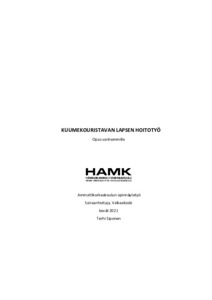Kuumekouristavan lapsen hoitotyö: opas vanhemmille
Siponen, Terhi (2021)
Avaa tiedosto
Lataukset:
Siponen, Terhi
2021
All rights reserved. This publication is copyrighted. You may download, display and print it for Your own personal use. Commercial use is prohibited.
Julkaisun pysyvä osoite on
https://urn.fi/URN:NBN:fi:amk-202105077560
https://urn.fi/URN:NBN:fi:amk-202105077560
Tiivistelmä
Tässä opinnäytetyössä käsiteltiin alle kouluikäisten lasten kuumekouristuksia ja niiden hoitoa sairaalassa sekä kotona. Opinnäytetyön keskeiset aiheet olivat mikä kuumekouristus on, kuinka kuumekouristusta hoidetaan ja kuinka kuumekouristelevan lapsen vanhempia ohjataan. Opinnäytetyön tarkoitus oli luoda opas kuumekouristelevan lapsen vanhemmille, jota hyödynnetään suullisen potilasohjauksen tukena ja annetaan kuumekouristavan lapsen vanhemmalle mukaan kotiin. Oppaan tavoitteena oli selkeyttää ja yhdenmukaistaa ohjaustilannetta sekä taata lapselle turvallinen hoito kotona. Työn tilaajana toimi Kanta-Hämeen keskussairaalan lasten- ja nuortenosasto 3A.
Kuumekouristus on yleisin alle kouluikäisten lasten tajuttomuuskouristuskohtauksen syy ja se uusii 20–30 % lapsista. Kuumekouristuksen perimmäinen syy on yhä tuntematon, mutta siihen vaikuttavat ainakin lapsen ikä ja perimä sekä lapsen infektio ja kuume. Kuumekouristuksia ei voida nykytiedon mukaan ennaltaehkäistä, sillä ei ole olemassa samanaikaisesti tehokasta ja turvallista estohoitoa. Kuumekouristavan lapsen hoitotyö sairaalassa koostuu lapsen peruselintoimintojen tarkkailusta, kouristuksen hoidosta sekä kuumeen hoidosta. Tilanteena lapsen kouristuskohtaus on pelottava, mutta yleensä kuumekouristus on vaaraton ja ohittuu jo muutaman minuutin kuluessa. Tämän vuoksi vanhempien ohjaus ja kotihoito-ohjeiden antaminen on tärkeässä roolissa kuumekouristavan lapsen hoitotyössä. This thesis dealt with febrile seizures of children under school age and their treatment in hospital as well as at home. The main topics of the thesis were what a febrile seizure is, how a febrile seizure is treated and how the parents of a child with a febrile seizure are guided. The purpose of the thesis was to create a guide for the parents of a child with febrile seizure, which is utilized as a support for oral patient guidance and given to the parent of the child with febrile seizures at home. The aim of the guide was to clarify and harmonize the guidance situation and to guarantee the child´s safe care at home. The client of the guide was the children and youth ward 3A of Kanta-Häme Central Hospital.
Febrile seizures are the most common cause of unconscious convulsions in children under school age and recur in 20-30% of children. The root cause of febrile seizures is still unknown, but it is affected at least by the child´s age and heredity, as well as the child´s infection and deafness. Nursing for a child with febrile seizure in the hospital consist of monitoring the child´s basic organ functions, treating the seizure and treating the fever. As a situation, a child´s seizure is frightening, but usually the febrile seizure is harmless and passes within a few minutes due to the recession. Parental guidance and home care instructions play an important role in caring for a child with febrile seizure.
Kuumekouristus on yleisin alle kouluikäisten lasten tajuttomuuskouristuskohtauksen syy ja se uusii 20–30 % lapsista. Kuumekouristuksen perimmäinen syy on yhä tuntematon, mutta siihen vaikuttavat ainakin lapsen ikä ja perimä sekä lapsen infektio ja kuume. Kuumekouristuksia ei voida nykytiedon mukaan ennaltaehkäistä, sillä ei ole olemassa samanaikaisesti tehokasta ja turvallista estohoitoa. Kuumekouristavan lapsen hoitotyö sairaalassa koostuu lapsen peruselintoimintojen tarkkailusta, kouristuksen hoidosta sekä kuumeen hoidosta. Tilanteena lapsen kouristuskohtaus on pelottava, mutta yleensä kuumekouristus on vaaraton ja ohittuu jo muutaman minuutin kuluessa. Tämän vuoksi vanhempien ohjaus ja kotihoito-ohjeiden antaminen on tärkeässä roolissa kuumekouristavan lapsen hoitotyössä.
Febrile seizures are the most common cause of unconscious convulsions in children under school age and recur in 20-30% of children. The root cause of febrile seizures is still unknown, but it is affected at least by the child´s age and heredity, as well as the child´s infection and deafness. Nursing for a child with febrile seizure in the hospital consist of monitoring the child´s basic organ functions, treating the seizure and treating the fever. As a situation, a child´s seizure is frightening, but usually the febrile seizure is harmless and passes within a few minutes due to the recession. Parental guidance and home care instructions play an important role in caring for a child with febrile seizure.
